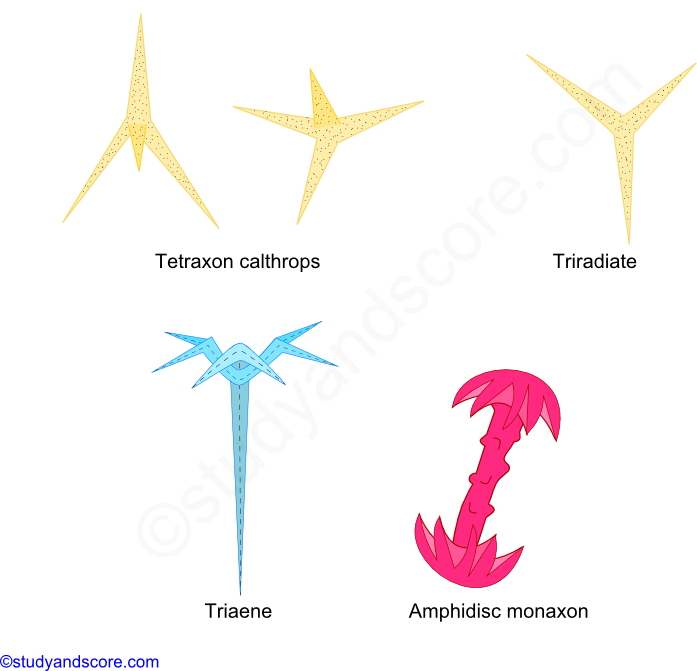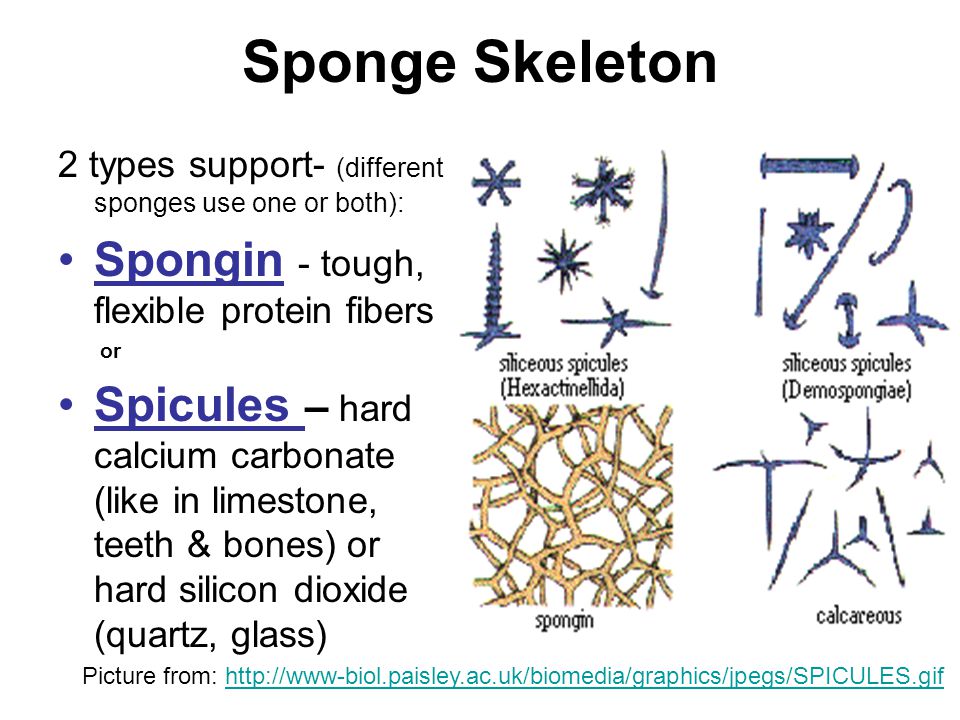Learn about bones and skeletons and distinguish between endoskeletons exoskeletons and hydrostatic skeletons. They are as follows.

Phylum Porifera Skeleton Of Sponges Spongin Fibers And Spicules Study Score
Appendicular skeleton bones of the limbs shoulders and pelvic girdle.

. Some Demospongiae found mainly on the coral reefs possess a compact. The spicules constitute major part of skeletal system which are secreted by special mesenchymal cells called scleroblasts. Those in the Demospongiae Lithistida form a heterogeneous group in which irregularly branched spicules desmas form a compact skeleton.
Phylum Echinodermata consists of the various symmetrical marine animals like the star fish sea urchins etc. Leucon type of canal system. The approximately 8550 living sponge species are scientifically classified in the phylum Porifera which is comprised of four distinct classes.
665 What type of nervous system do sponges have. Describe the different types of sponge skeletons. Taxonomists group sponges into three types based on the composition of their skeletons.
The skeletal system has three types of skeletons that support the body. In harder sponges the skeleton is made up of spiny spicules. What Are The Different Kinds Of Sponges And Coelenterates.
Describe the skeletons of each class of sponges. Calcarean sponges of order Pharetronida have skeletons formed by an amorphous mass of calcium carbonate with which few spicules are associated. Solutions for Chapter 12 Problem 8RQ.
Sponges are single calcarea glass spones. The meshing of many spicules serves as the sponges skeleton and thus it provides structural support and potentially defense against predators. These are the small spicules occurring interstitially.
Softer sponges have an internal skeleton made of sponging a network of flexible protein fibers. As a whole poriferans have diverse skeletal elements including calcareous laminae organic filaments and siliceous and calcareous spicules. Spicules may occur in several forms like the simple rod form or in the form of forks anchors shovels stars plumes etc.
Harder sponges spicules made of calcium carbonate or glasslike silica. Ascon sycon and leucon. Corals jellyfish and comb jellies are types of coelenterates.
The Skeletons of Sponges. Its skeleton is a compound of organic fibres a base of calcite and aragonite and spicules of silica. Sponges like all animals possess some sort of a skeleton that gives their bodies shape.
The organisation of sponges has been grouped into three main types viz ascon type sycon type and leuconoid type due to simplicity in some forms and complexity in others. Axial skeleton bones of the skull vertebral column thoracic cage. Different skeletons have adapted to different methods of locomotion The various types of skeletons are an adaption to the environment in which the animal lives.
Here the endoskeleton is for support. This type of canal system results due to further folding of body wall of the sycon type of canal system. The base and inner tissue are light beige to buff and specimens growing in dark areas may be pale.
These are the soft elastic sponges some of which are harvested for household and commercial use. It has a dark brown to walnut brown or beige color. Sponge Structure and Function Sponges have three different body plans of sponges and use flagellated cells to pull seawater into their bodies to obtain particles of food.
Spicules are formed by carbonates of lime or silica in the form of needle like pieces. Characteristics of an Ocean Ridge. These are proteinaceous secretion of the spongioblasts and form a network.
Phylum Porifera are sponge like animals and has almost 5000 species. So the correct answer is Endoskeleton. Air land or water The different types of skeletons are.
On the basis of number of axes and rays. Sponges have a simple skeleton. The classification of Porifera is based chiefly on types of skeleton found in them.
These sponges have multiple ostia this is where water enters the sponge and only have one osculum where water exits the spongeThe openings lead to the sponges one central chamber called a spongocoel. Chicken Liver Sponge also known as Chondrilla Nucula. Ascon sponges are the simplest and least common sponge body from.
Large spicules visible to the naked eye are referred to as megascleres while smaller microscopic ones are termed microscleres. Since there are no visceral organs in the skeleton of sponges their skeleton can not be categorised into external or internal category. Glass sponges have spicules made of silica.
The skeletons of each of the major poriferan groups are distinctive and have been used to reconstruct their evolutionary. The Demospongiae the most diverse containing 90 percent of all living sponges Hexactinellida the rare glass sponges Calcarea calcareous sponges and Homoscleromorpha the rarest and simplest class only recently recognized. This is due to the development of cortex involving pinacoderm and mesenchyme spreading over the entire outer surface of sponge.
Types of Sea Snakes. O Hydrostatic skeletons o Exoskeletons o Endoskeletons Hydrostatic Skeletons. The other 20 percent belong to the class Calcispongiae which have spicules made of calcium carbonate and the Hyalospongiae which have spicules made.
Endoskeleton- the skeleton on the outside Exoskeleton- the skeleton on the inside Vertebrate-. The sponges possess an endoskeleton in the form calcareous spicules made up of calcium carbonate siliceous spicules made up of silica and spongin fibres. About 80 percent of sponges belong to the class Demospongiae and have a skeleton made of spongin.
Get solutions Get solutions Get solutions done loading Looking for the textbook. Up to 24 cash back There are three types of sponge body forms. This canal system is the characteristic of the leuconoid type of sponges like Spongilla.
The following points highlight the two main skeletal elements found in sponges. Answer to Describe the skeletons of each class of sponges. The three classes of sponges are shown in Figure 4.
Skeletal structures of sponges are spicules and spongin fibres. What Are The Different Kinds Of Skeleton. Calcareous sponges have spicules composed of calcium carbonate.
In some species the spon-gin is reinforced with spicules of silica. Describe the different types of sponge skeletons. Spongin fibres are composed of a silk-like scleroprotein.
Sponge spicules are made of calcium carbonate or silica. These are larger spicules constituting main skeleton of sponge body. Softer sponges spongin flexible protein fibers p.
The spongin comprises of fibres of spongin and they resemble silk in appearance.

Chapter 33 Porifera Sponges Ppt Video Online Download

Phylum Porifera Skeleton Of Sponges Spongin Fibers And Spicules Study Score

0 Comments